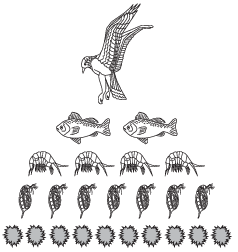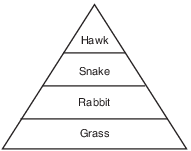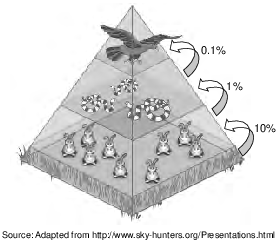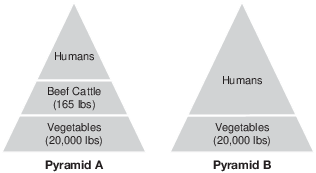Topic: (Nysed) Matter Cycled Through Organisms And Ecosystems
(Nysed) Matter Cycled Through Organisms And Ecosystems
The diagram below does not represent a sustainable energy pyramid in an ecosystem because

(1) energy is never transferred between levels in ecosystems
(2) ecosystems never have more than three levels of energy transfer
(3) more energy must be available in the producer level than in the consumer levels
(4) producers feed on herbivores in most ecosystems
The diagram below represents different feeding levels in an energy pyramid.

The most likely explanation for showing fewer organisms at each feeding level going up the pyramid is that
(1) some energy is lost to the environment as heat
(2) the larger the organism, the less energy it requires
(3) some energy is recycled within each level and remains there
(4) decomposers convert most of the energy into inorganic compounds
After feeding at the surface of the ocean during the day, many ocean organisms migrate to deeper waters. While there, they release ammonia in their urine. Many bacteria use the nitrogen from the ammonia as they make amino acids, which eventually end up in food chains on both land and water. These amino acids may even be used in humans. Which statement best explains these observations?
(1) Chemical elements, including nitrogen, pass through food webs and are combined and recombined in different ways.
(2) Chemical elements, including nitrogen, are removed from food webs and eliminated from ecosystems.
(3) Nitrogen is transferred directly from bacteria to humans.
(4) All elements in the ocean remain there and are not transferred to other ecosystems.
Which process occurs at each link in a food chain?
(1) All the energy is stored in a newly made structure.
(2) Some energy is released into the environment as heat.
(3) Chemical energy is recycled.
(4) Atoms cycle among living organisms, producing energy.
The diagram below represents a food pyramid in an ecosystem.

The best explanation for the decrease in the amount of energy transferred to each succeeding level is that much of the energy is
(1) consumed by predators
(2) released as heat
(3) stored within inorganic materials
(4) used in photosynthesis
The most likely result of completely removing carbon dioxide from the environment of a plant is that sugar production will
(1) continue at the same rate
(2) increase and oxygen production will also in- crease
(3) increase and oxygen production will stay the same
(4) decrease and eventually stop
A hummingbird may need to consume up to 50% of its body weight in sugar each day, just to meet its energy needs. Some of this energy is stored and some is used for metabolic activities, but much of the energy is
(1) converted into amino acids needed for the production of starch
(2) released as heat energy back into the hummingbird’s environment
(3) changed into radiant energy, which can be used by plants for photosynthesis
(4) used to synthesize inorganic compounds necessary for cellular respiration

Explain why there is a different amount of energy represented at each level of this energy pyramid. [1]
Allow 1 credit. Acceptable responses include, but are not limited to:
• — As energy is transferred at each feeding level, some is lost as heat.
• — Some of the energy is lost at each step of the energy pyramid.
• — About 90% of the available energy is lost at each feeding level.
• — Some energy is used for life functions.
• — At each level, only about 10% is passed on to the next level.

Based on the information in the diagram, only some of the available energy is transferred from one energy level to the next. State what happens to the rest of the energy. [1]
Allow 1 credit. Acceptable responses include, but are not limited to:
• — The remaining energy is mostly given off/lost as heat.
• — It is given off as heat.
• — Some energy is used for metabolic processes.
The diagram below represents two energy pyramids. Each pyramid represents the productivity of one acre of land.

Based on the concept of energy transfer, explain why one acre of land can produce more vegetables for human consumption than beef for human consumption. [1]
Allow 1 credit. Acceptable responses include, but are not limited to:
• — Energy is lost as heat at each feeding level, and pyramid B has fewer levels.
• — Consumers that feed directly on plants have more energy available to them than consumers
• feeding on other consumers, since energy is lost at each level.
• — Raising cattle on the land is not as productive because energy must be transferred from
• plants to the cattle and then to people. Much energy will be lost as heat.

State one reason why there is less energy available at each trophic level going from the first to the third trophic level. [1]
Allow 1 credit. Acceptable responses include, but are not limited to:
• — Energy is lost at each level as heat.
• — Some energy is used by the organisms at each level and is not available to the organisms at
• the next level.
• — Energy is lost.
